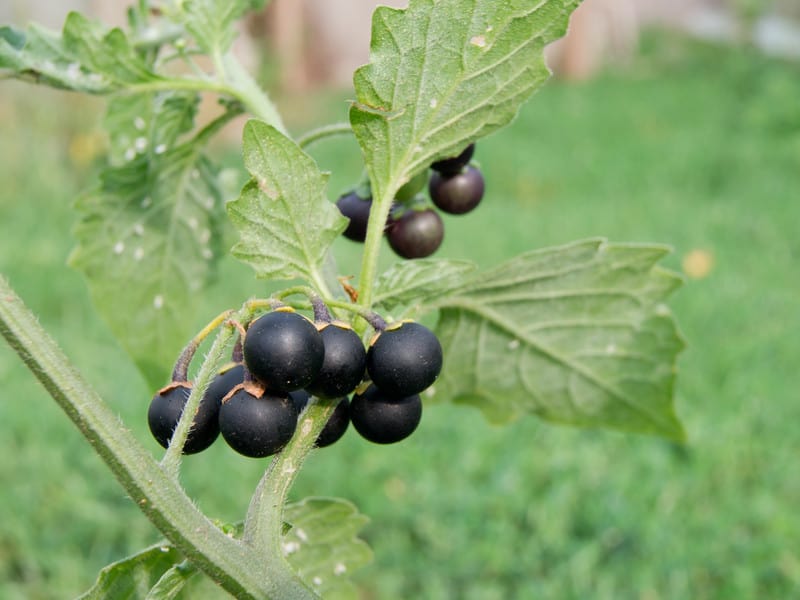Black nightshade—also called deadly nightshade–is the most common of several nightshade weeds. The nightshades are close relatives of tomatoes, potatoes, and eggplants. The leaves and berries of nightshades contain toxic alkaloids that are harmful to humans and animals.
Hairy nightshade and cut leaf nightshade are two other garden weeds similar to black nightshade. Nightshades are annuals and sometimes short-lived perennials.
Scientific name: Solanum nigrum (black nightshade); S. sarrachoides, hairy nightshade; S. triflorum, cutleaf nightshade.
Organic Weed Control at Amazon
- Monterey Vegetable Pre-Emergent Weed Control
- Homietina Heavy Duty Weed Barrier Fabric 4×300-feet
- Preen Natural Vegetable Garden Weed Preventer
- Green Gobbler 20% Vinegar Weed and Grass Killer
- WeedGuard Plus Biodegradable Paper Weed Barrier

Black nightshade description and life cycle
- Black nightshade grows from 6 inches to 2½ feet tall with branching stems that may stand erect or lie on the ground.
- Stems are triangular-shaped.
- Leaves are egg-shaped, with smooth or wavy margins.
- Leaves are alternate on the stem.
- White or pale blue flowers are five-petaled and resemble tomato flowers, drooping in clusters.
- Small berries in bunches are dull green when young and black when mature; berries are toxic but not very palatable.
- When plant parts are eaten they can cause vomiting, abdominal pain, bloody diarrhea, difficulty breathing, lack of coordination, weakness, collapse, convulsions, and possible death. Animals, pets, and humans should not eat black nightshade.
- Reproduces by seed; seeds are small, yellow-to-brown, dull, and flattened.
- Blooms in late summer.
- Commonly found in disturbed soil or sometimes where root crops have grown.
- Member of the Solanaceae family; same as tomatoes, potatoes, and eggplants.
Black nightshade root system
Nightshades have a slender taproot that branches frequently.
Black nightshade organic control
- Remove young plants immediately; dig out the taproot.
- Do not let the plant flower or drop seed.
- Mulch to prevent seeds from germinating.
- Place clear plastic on infested areas and solarize to kill seeds.
- Nightshades can host Colorado potato beetles and late blight fungus.
Black nightshade range
Eastern half of the United States and southeastern Canada.
Four quick ways to control weeds
- Weed early. Control weeds in the first month after they germinate.
- Weed often. Hand weed every two weeks through the season.
- Weed by hand when the soil is wet (best to get roots).
- Use a hoe if the soil is dry. Decapitate weeds before they flower and drop seed.
Related articles:
Vegetable Garden Organic Weed Control
Vegetable Garden Organic Pest Control
Vegetable Garden Diseases Problem Solver
Garden Planning Books at Amazon:
- Vegetable Garden Almanac & Planner
- Kitchen Garden Grower’s Guide Vegetable Encyclopedia
- Vegetable Garden Grower’s Guide
- Tomato Grower’s Answer Book



